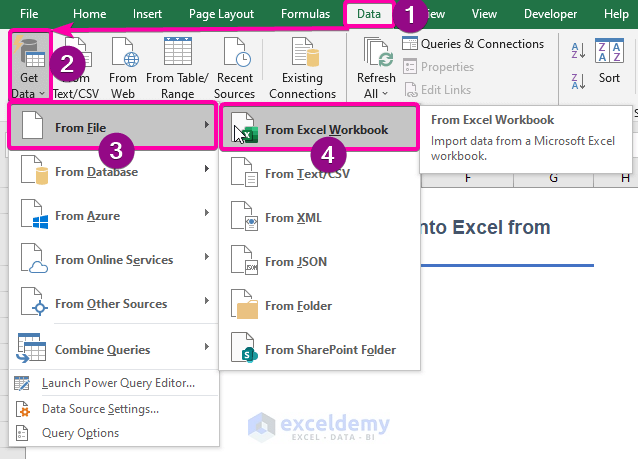Import Data from Excel Sheets: Simple Methods

In today's fast-paced business environment, data integration and efficiency are crucial for productivity. Importing data from Excel spreadsheets into various systems has become a routine task for many professionals. This process can be quite straightforward with the right tools and techniques. Let's explore the simple methods available for importing data from Excel sheets, ensuring that you can manage your data effectively.
Understanding Excel Data

Before diving into the methods of importing data, it’s essential to understand how Excel stores data:
- Data Organization: Excel uses a grid system where data is organized in rows and columns. Each cell can hold a single piece of information, making Excel an intuitive tool for storing tabular data.
- Data Formats: Excel supports multiple data types including text, numbers, dates, and formulas, which can sometimes complicate data import due to type conversion.
- File Formats: Excel files can be saved in various formats like .xlsx, .xls, .csv, and .ods, each affecting how data is read by different applications.
📝 Note: Always ensure the data in your Excel file is clean, formatted correctly, and free from unnecessary formatting or merged cells to facilitate smooth import.
Importing Excel Data into Databases

One of the most common use cases for importing data from Excel is database integration:
- Using SQL Server Import and Export Wizard: If you are working with Microsoft SQL Server, the built-in Import and Export Wizard simplifies the process:
- Open SQL Server Management Studio (SSMS).
- Right-click your database, go to “Tasks,” and select “Import Data…”
- Choose “Excel” as your data source.
- Specify the path to your Excel file and configure import settings.
- Map Excel columns to database columns, then proceed with the import.
- ODBC Drivers: Open Database Connectivity (ODBC) allows you to connect Excel to various databases:
- Set up an ODBC connection in your system's ODBC Data Source Administrator.
- Configure the driver for your specific database (e.g., MySQL, Oracle).
- Use SQL or programming languages like Python or R to write data from Excel to your database through the ODBC connection.
- ETL Tools: Tools like Talend, Pentaho, or Informatica provide robust methods for data import:
- Configure source as Excel and target as your database.
- Set up transformations if needed for data cleaning or mapping.
- Run the job to import data.
⚠️ Note: When importing data into databases, consider data integrity, especially with unique identifiers, to avoid duplication or data inconsistency.
Importing Excel Data into Spreadsheets and Text Files

Importing data between spreadsheets or into different text file formats is also a common task:
- Importing Into Google Sheets:
- Open Google Sheets.
- Go to "File" > "Import," select your Excel file, and choose how you want to import the data.
- Ensure you select "Replace spreadsheet" or "Insert new sheets" based on your need.
- CSV Format:
- Save your Excel file as CSV (Comma-Separated Values) to ensure compatibility with a broad range of applications.
- Open the target application and import the CSV file, mapping fields as required.
- Using Python Pandas: Python with Pandas can handle both Excel and CSV:
import pandas as pd # Reading from Excel df = pd.read_excel('data.xlsx', sheet_name='Sheet1') # Saving to CSV df.to_csv('data.csv', index=False) # Reading from CSV data_from_csv = pd.read_csv('data.csv')
Importing Excel Data into Web Applications

Web applications often require integration with external data sources like Excel:
- JavaScript:
- Use libraries like Papa Parse or SheetJS to read Excel files in the browser or on the server.
- Implement file upload functionality, read the data, and send it to your backend for processing.
- Server-Side Programming:
- Languages like Python, Node.js, or PHP can handle file uploads, then parse the Excel file using libraries such as openpyxl or node-xlsx.
- After parsing, you can save the data into your web application’s database or process it for display.
🌐 Note: Ensure your web application handles large files properly, possibly chunking uploads or implementing file size limits for better user experience.
Concluding Thoughts

Importing data from Excel sheets isn’t just about technical know-how but understanding the implications of data structure, integrity, and the broader context of your data usage. Whether you’re dealing with databases, spreadsheets, or web applications, there’s a method tailored for your needs. Remember that each method has its strengths and considerations, from SQL Server’s simplicity to the flexibility of Python’s Pandas. Keep in mind the need for data cleanliness, and always consider how data integration can streamline your workflow and improve decision-making in your organization.
What are the key considerations before importing Excel data?

+
Ensure your data is clean, free from unnecessary formatting, and that any data types like dates or numbers are correctly formatted for compatibility with the target system.
How do you handle large datasets when importing?

+
Use batch processing, implement chunking of data, or consider using ETL tools that are optimized for handling large volumes of data efficiently.
Can I automate the import process from Excel to my application?

+
Absolutely. Many programming environments support automated data import. For instance, Python with Pandas can be scheduled to read Excel files at specific times, or web applications can offer automated data import features.



